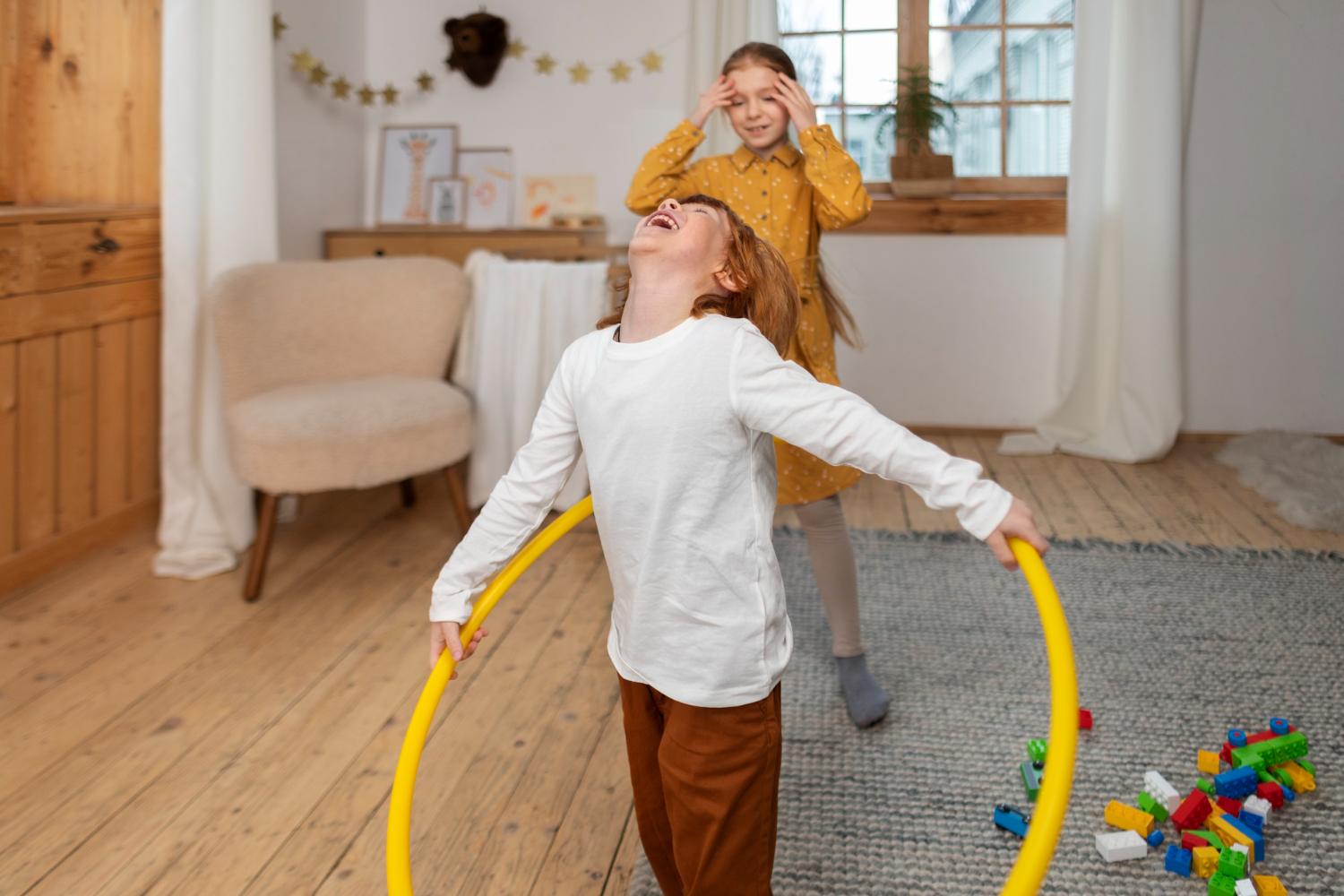
How to Use ABA Strategies to Encourage Play and Exploration
Engaging Strategies to Foster Play and Exploration Through ABA Techniques
Unlocking the Potential of Play with ABA Methods
Play is a vital component of childhood development, serving as a foundation for social, communication, cognitive, and emotional growth. When integrated with Applied Behavior Analysis (ABA), play transforms into a powerful tool for encouraging exploration and skill development, especially in children with autism. This article explores effective ABA strategies and practical tips for supporting children’s play and exploration, facilitating meaningful learning experiences across various environments.
Building Comfort and Engagement in Play

How can therapists and parents encourage interactive play among children?
Encouraging children to engage in interactive play is vital for their social and emotional development. Therapists and parents can start by providing a variety of toys that naturally promote interaction, such as balls, blocks, puppets, and costumes. These toys invite children to participate in activities like Peek-a-Boo, hide-and-seek, and ring-around-the-rosy, which foster turn-taking and social bonding.
Facilitating pretend or dramatic play with props based on real-world scenarios encourages imagination and communication. Setting up structured games like board games or collaborative activities teaches children cooperation, sharing, and problem-solving skills while keeping play enjoyable.
Observing the child's specific interests and preferences allows caregivers to tailor play activities, making them more engaging. This personalized approach not only motivates children to participate but also supports cognitive, social, and emotional growth.
How can providers support children's development of leisure and play skills?
Supporting the development of leisure and play skills involves offering activities aligned with each child's interests and developmental level. Providers can model appropriate play behaviors and use visual cues such as picture schedules to guide children through new activities.
Breaking down complex tasks into smaller steps helps children learn with confidence. For example, teaching a child to play with a new toy involves demonstrating its use, guiding their initial attempts, and gradually increasing independence.
Making activities predictable, enjoyable, and tailored encourages continued engagement. Incorporating peer-based activities like game clubs or shared hobbies enhances social skills and creates opportunities for friendship.
To ensure success, professionals should assess individual preferences using various tools and observations. This personalized approach ultimately promotes independence and improves quality of life.
What are some tips for facilitating play and exploration in children with developmental delays or autism?
Facilitating play and exploration requires creating a supportive environment filled with sensory-friendly and engaging activities. Providers should select toys that cater to the child's interests and sensitivities, such as textured objects or weighted toys, to support sensory processing.
Using structured techniques like role-playing and imaginative games encourages communication and social interaction. For example, activities like 'put in/take out' can enhance fine motor skills and patience.
Supporting the child's lead by narrating actions, modeling play behaviors, and offering choices fosters trust and language development. Visual aids, schedules, and sensory tools help children engage and regulate emotionally.
Creating a safe, playful environment that emphasizes exploration and independence allows children to develop curiosity, confidence, and emotional resilience. Consistent, child-led interactions promote meaningful growth in most developmental areas.
How does the 5-step process promote play skills?
The process involves five key steps to systematically teach play skills: building comfort with adult presence, gently shaping play experiences, expanding play sequences, welcoming peers, and fostering interactive peer play. This gradual approach ensures children are comfortable and motivated.
Beginning with exposure to structured environments helps children feel safe. Using reinforcement and modeling encourages participation and inspires exploration.
Expanding play involves introducing new elements that connect with the child's interests, subtly increasing complexity. Inviting peers and facilitating social play deepens interaction and promotes generalization of skills.
Patience and flexibility are crucial throughout, as the child's needs and progress are continuously monitored and strategies adjusted accordingly. This systematic, nurturing approach makes learning play both effective and enjoyable.
| Step | Focus Area | Techniques and Goals |
|---|---|---|
| 1. Building comfort | Trust with adults | Gradual exposure, supportive environment |
| 2. Gently shaping play | Engagement and imitation | Modeling, prompting, reinforcement |
| 3. Expanding sequences | Exploration and skills growth | Introducing new activities, themed play |
| 4. Welcoming peers | Social interaction | Facilitating peer play, turn-taking |
| 5. Fostering peer play | Social mastery | Encouraging sustained, reciprocal interaction |
This framework ensures structured growth in play skills, fostering independence, socialization, and joy in children undergoing ABA therapy.
Fundamental ABA Techniques for Enhancing Play Skills
What methods are effective for teaching play skills using ABA?
Teaching play skills through ABA involves a blend of structured and naturalistic strategies that engage children in meaningful ways. Discrete Trial Training (DTT) is a systematic approach where skills are broken down into small, manageable steps, and children are provided with clear cues and reinforcement to encourage specific play behaviors.
Natural Environment Teaching (NET) focuses on incorporating learning into everyday settings, making play relevant and motivating. This method emphasizes spontaneous interactions, child-led activities, and using natural reinforcers such as praise or preferred toys.
Pivotal Response Training (PRT) targets pivotal areas such as motivation, self-initiation, and response to multiple cues. By focusing on these, children gain broader social and communication skills through play.
In addition to these strategies, visual supports and modeling are crucial. Visual supports—like picture schedules and social stories—help clarify expectations and promote independence. Modeling, where therapists or caregivers demonstrate play behaviors, allows children to imitate and learn through observation.
Gradual skill acquisition is achieved via chaining, prompting, and reinforcement, ensuring children build confidence and competence over time. Consistent data collection and ongoing assessment tailor these approaches to each child's needs, making learning engaging and effective.
How can ABA strategies be used to promote play and exploration in children?
ABA techniques foster play and exploration by aligning activities with a child's interests, thus boosting motivation. Therapists often start by observing the child's current play patterns to identify preferences, such as toys or themes.
Joining and imitating the child's play creates a positive environment where children feel supported and understood. For example, if a child likes trains, the therapist can participate with train toys, modeling ways to manipulate or pretend with them.
Gradually, the therapist expands the play by introducing new related activities, using step-by-step chaining and prompting to shape more complex behaviors. This might include counting blocks, building structures, or integrating storytelling elements.
Reinforcement plays a vital role: praise, high-fives, access to favorite toys, or social rewards motivate children to explore further. Embedding naturalistic routines and providing sensory-friendly materials like playdough or water adds sensory engagement, particularly for children with sensory sensitivities.
By consistently applying ABA principles—such as reinforcement, prompting, and visual cues—in familiar settings, children develop problem-solving skills, language, and social interactions, transforming play into a joyful and educational experience.
Strategies to Support Interactive and Peer Play
How can therapists and parents encourage interactive play among children?
Encouraging interactive play in children, especially those with autism, involves a combination of engaging tools, organized activities, and supportive environments. Therapists and parents can start by providing a variety of toys that naturally promote social engagement, such as balls, blocks, puppets, and dress-up costumes. These toys serve as conversation starters and encourage turn-taking.
Activities like Peek-a-Boo, hide-and-seek, and ring-around-the-rosy foster social interaction, emotional comfort, and cooperation. Organizing structured playdates and facilitating pretend or dramatic play—such as acting out real-world scenarios with props—are excellent ways to promote imagination, communication, and social skills.
Using structured games, including board games and collaborative activities, can reinforce sharing, problem-solving, and cooperation in fun settings. Observing children's preferences and interests allows caregivers to tailor activities, making play more engaging and supportive of cognitive and emotional development.
Overall, combining diverse toys, interactive activities, and attentive facilitation helps build foundational social skills vital for children’s growth.
How can caregivers and educators support the development of play skills in children with autism?
Supporting children with autism in developing play skills involves creating a predictable, inviting environment filled with visual supports, activity schedules, and sensory routines. These tools help children understand what to expect and become more comfortable engaging in play activities.
Modeling play behaviors through live demonstrations or video models provides clear examples for children to imitate. Systematic prompting and script training can guide children through new play behaviors, gradually fostering independence.
Teaching social skills like greeting peers, requesting turns, or inviting others to play encourages reciprocity and relationship building. Reinforcement strategies, such as praise, tokens, or access to preferred toys, motivate children and recognize their progress.
Incorporating children’s restricted interests into play activities can make learning more appealing. Chaining techniques, where complex actions are broken into smaller steps, facilitate mastery of multi-step play routines.
Finally, practicing skills across different settings and with various people helps children generalize what they learn, making play more adaptable and meaningful for everyday life.
Creating Supportive Environments for Play and Exploration
 Establishing an environment conducive to play and exploration is fundamental in ABA therapy for children with autism. Structured play spaces are thoughtfully organized to promote engagement, with designated areas that encourage different types of play, such as sensory play and functional activities. Sensory activities using materials like sand, water, or playdough help children with sensory sensitivities to feel comfortable and engaged, fostering creativity and exploration.
Establishing an environment conducive to play and exploration is fundamental in ABA therapy for children with autism. Structured play spaces are thoughtfully organized to promote engagement, with designated areas that encourage different types of play, such as sensory play and functional activities. Sensory activities using materials like sand, water, or playdough help children with sensory sensitivities to feel comfortable and engaged, fostering creativity and exploration.
Visual cues, such as picture schedules and visual supports, serve as effective tools to guide children through routines and activities. These cues facilitate understanding, reduce anxiety, and help children anticipate what comes next, making transitions smoother and play sessions more productive. Implementing structured routines with visual supports also reinforces learning and encourages independence.
Environmental adaptations are critical for children with sensory processing differences. For example, minimizing loud noises, using calming lighting, and providing sensory-friendly toys or tools can create a more welcoming and less overwhelming setting. These adjustments support children in staying engaged and exploring freely without overstimulation, which is essential for fostering positive play experiences.
Supported Strategies for Play Development
| Strategy | Description | Purpose |
|---|---|---|
| Organized play spaces | Well-arranged areas that cater to different types of play | Promote structured exploration and comfort |
| Sensory activities | Use of sensory materials like playdough or water | Engage sensory-sensitive children |
| Visual cues and routines | Picture schedules, visual supports, structured routines | Aid comprehension and smooth transitions |
| Environmental modifications | Noise control, calming lighting, sensory-friendly toys | Minimize overstimulation and encourage exploration |
How do ABA strategies support social and play skills?
In ABA, a variety of techniques work together to foster social and play development. Positive reinforcement rewards appropriate behaviors, motivating children to repeat play and social interactions. Video modeling and visual supports serve as models and prompts for social behaviors, teaching children through imitation.
Prompting helps guide children towards new skills, while fading techniques ensure they gain independence gradually. Natural Environment Teaching (NET) allows children to practice skills in real-world settings, aiding generalization. Behavior chaining and social stories also help children understand sequences of actions and social norms, making interactions more meaningful.
How can caregivers and educators support the development of play skills?
Caregivers and educators play a vital role by creating inviting environments rich in visual supports and sensory activities. Modeling—both live and via videos—teaches children how to engage in play and interact socially. Using systematic prompting and scripts helps children learn specific play behaviors and social routines.
Teaching skills like greeting others, sharing toys, and inviting peers into play helps develop essential social competencies. Reinforcing these behaviors with praise and encouragement ensures children remain motivated. Incorporating children’s personal interests, especially restricted interests, into play activities makes sessions more engaging and meaningful.
Gradually increasing the complexity of play tasks and practicing skill sequences through chaining techniques promote flexible and advanced play skills. Facilitating practice across various settings and with different people ensures that skills are generalized and become part of the child's everyday repertoire.
Supporting Play Development: Practical Tips
- Use modeling to demonstrate how to play with toys or engage in pretend play.
- Break down complex play behaviors into small, manageable steps using task analysis.
- Incorporate sensory activities to engage children with different sensory needs.
- Set up playdates or peer interactions to foster social skills.
- Celebrate progress and milestones to boost motivation and confidence.
Creating environments that are organized and sensory-friendly, combined with consistent, supportive teaching strategies, transforms ABA play sessions into engaging learning experiences. Such efforts promote not only play skills but also communication, socialization, and overall cognitive development.
Using Play to Foster Cognitive, Language, and Social Development
How does ABA support the development of communication and language skills?
ABA employs a variety of structured play-based strategies to enhance language and communication abilities in children with autism. Techniques like Discrete Trial Training (DTT), Pivotal Response Training (PRT), and Natural Environment Teaching (NET) focus on teaching functional communication through engaging activities. For example, children are taught to request, label, and respond using toys, pictures, or gestures, often reinforced with praise, access to preferred items, or other rewards.
Breaking down language tasks into small, manageable steps allows children to learn gradually and confidently. Modeling correct speech and prompting children to imitate sounds and words are common practices. Visual supports, such as picture schedules and social stories, help children understand expectations and respond appropriately in social interactions.
Patience and consistent reinforcement are essential to progress, emphasizing a positive, encouraging environment that makes language learning fun and relevant.
How does play enhance social interactions and peer relationships?
Play is central to developing social skills, including turn-taking, sharing, and understanding others’ emotions. ABA therapy emphasizes structured and naturalistic play to foster these skills. Strategies like modeling, prompting, and reinforcing social behaviors encourage children to participate more actively with peers.
Creating opportunities for joint play, such as playdates or facilitated group activities, allows children to practice social exchanges in a safe setting. Using visual supports like social stories can teach expected behaviors during interactions. Setting up play environments with organized spaces and sensory activities helps children feel comfortable engaging with others.
Encouraging peer play and supervising interactions help children develop friendship skills and emotional regulation. Over time, children learn to initiate and maintain social interactions, building stronger peer relationships.
In what ways does play contribute to problem-solving and cognitive flexibility?
Play serves as a natural platform for children to develop problem-solving skills and cognitive flexibility. ABA strategies incorporate play activities like puzzles, building blocks, and pretend scenarios that challenge children to think creatively and adapt to new situations.
Breaking tasks into smaller steps through task analysis helps children learn to approach problems systematically. Reinforcing efforts and successes motivates continued exploration and persistence.
Using guided play, children practice experimenting with different solutions, which enhances their adaptability and flexibility. For instance, during pretend play, children might explore different roles or alter scenarios, encouraging flexible thinking.
Incorporating sensory play with materials such as sand or water can also support exploration and experimentation, fostering curiosity and resilience in learning.
What strategies are commonly used in ABA to support social and play skill development?
| Strategy | Description | Example |
|---|---|---|
| Positive Reinforcement | Rewards for appropriate social or play behaviors | Praising a child for sharing toys after playtime |
| Video Modeling | Demonstrating desired behaviors through videos | Showing a peer sharing toys and playing cooperatively |
| Visual Supports | Using visual aids to prompt and support behavior | Picture schedules for daily routines |
| Prompting and Fading | Guiding behaviors initially and reducing assistance gradually | Hand-over-hand guidance followed by independent play |
| Natural Environment Teaching | Teaching skills in real-life meaningful contexts | Playing with kitchen toys during snack prep |
| Behavior Chaining | Linking simple behaviors to form complex activities | Putting on shoes, then tying laces |
| Functional Communication Training | Teaching children to express needs effectively | Using pictures to say |
Implementing a Child-Centered Play Approach with ABA Principles
How can ABA strategies be used to promote play and exploration in children?
ABA strategies are highly effective when adapted to each child's interests and current skills in play. Therapists and caregivers often start by joining the child in their preferred activities, demonstrating acceptance and building trust. They then imitate what the child is doing, which encourages the child's engagement and modeling.
Next, they gradually expand play by introducing new, related activities that build on the child's existing interests. For instance, if a child enjoys building with blocks, an adult might introduce counting or stacking challenges to extend the play. Reinforcement—such as praise, smiles, or access to favorite toys—helps motivate children to participate more actively.
Incorporating natural play environments and child-led routines makes exploration more inviting and less intimidating. These strategies foster not just play skills but also social, communication, and problem-solving abilities. Using ABA in this way transforms play into a rich learning experience that encourages curiosity, independence, and discovery.
How does a 5-step process support teaching play skills?
The outlined five-step process begins with helping children become comfortable with adult presence, creating a safe space for interaction. In the second stage, therapists gently shape the child's play experiences by modeling and prompting behaviors, slowly introducing new elements.
As children progress, the focus shifts to expanding their play sequences to include more complex activities. Welcoming peers into play sessions encourages social interaction and cooperative play. The final step emphasizes fostering interactive peer play, where children learn to share, take turns, and collaborate.
This systematic approach relies on patience, consistency, and reinforcement. It ensures children develop a broad range of play skills, from solitary play to engaging in nuanced social exchanges.
Why is the environment important in play development?
A thoughtfully organized environment significantly influences a child's ability to develop play skills. Organized play spaces with accessible, diverse toys and sensory activities encourage exploration. Sensory-rich materials like playdough, sand, or water engage children with sensory sensitivities and promote creativity.
Adult supervision is vital to guide children through play stages without overwhelming or controlling them, fostering autonomy. Including visual supports and routines helps children understand expectations, reducing anxiety and promoting sustained engagement.
Creating a rich, inviting environment supports generalization of play skills across settings—home, school, or therapy centers—and helps children feel confident to explore and interact.
What practical tips support the integration of ABA and play?
Practical tips include not replacing toys when adults join play, allowing children to feel in control and encouraging ongoing engagement. Using modeling—demonstrating how to use toys or engaging in pretend play—serves as a gentle way to teach new behaviors.
Reinforcing progress overall motivates children to continue developing their skills. Breaking down complex play activities into smaller, manageable steps through task analysis makes learning less overwhelming.
Parents and therapists can also set up playdates or facilitate interactions with peers, which supports social skill development. Patience and flexibility are essential; strategies should adapt based on the child's responsiveness and specific needs.
How can goal-oriented play support ongoing development?
Goal-oriented play aligns activities with developmental objectives, such as improving social interaction, communication, or cognitive skills. Carefully planning sequences that grow in complexity ensures continuous progression.
Using prompting, reinforcement, and modeling during play encourages mastery of new skills and increases motivation. Collecting data on each child's responses allows for tailored adjustments, optimizing each child's learning trajectory.
In sum, integrating systematic ABA strategies into play supports a holistic developmental approach, transforming playtime into an effective, engaging learning experience. By emphasizing continuous assessment and individualized support, children are encouraged to explore, communicate, and connect more meaningfully.
| Approach | Description | Focus Area |
|---|---|---|
| Discrete Trial Training (DTT) | Structured, teacher-led trials for specific skills | Learning specific play behaviors |
| Natural Environment Teaching | Child-led play in everyday settings, free from rigid routines | Generalization and spontaneous play |
| Pivotal Response Training | Focus on motivation, responsivity, and self-management | Social and communication skills |
Overall, these strategies foster play development by making learning engaging, respectful of the child's pace, and rich in opportunities for social growth.
The Central Role of Environment and Motivation in ABA Play Interventions
How should the environment be organized to maximize engagement in ABA play strategies?
Creating a well-structured and inviting environment is vital for encouraging play and learning in children undergoing ABA therapy. Organized play spaces should be filled with toys, sensory materials, and visual supports that match the child's interests and developmental level. Clearly defined areas for different types of play—such as sensory bins, imitation stations, or pretend play zones—help children understand expectations and navigate activities comfortably.
Arranging toys and materials at accessible heights promotes independence, while minimizing clutter reduces distractions and encourages focus. Using visual cues, like picture schedules or labeled bins, supports transitions and self-directed play. An environment that is predictable yet flexible fosters a sense of safety, motivating children to explore and engage in new or challenging activities.
Organizing the environment for optimal engagement enhances the effectiveness of ABA strategies by providing consistent, motivating conditions for skill development.
Supporting Developmental Goals and Progress Tracking in ABA Play Therapy

How do we assess a child's current play skills and interests?
Understanding where a child stands in their play development is the first step in effective ABA therapy. Therapists observe the child's current play behaviors, noting their preferred toys, typical activity patterns, and level of social engagement. Questions like what objects the child gravitates toward, how they interact with toys, and whether they initiate or respond to play are crucial. This assessment helps identify existing strengths and areas needing support.
Therapists also explore a child's interests, such as favorite themes or objects, to tailor interventions that motivate engagement. For example, a child who loves trains can have train-themed toys incorporated into play routines to foster participation and exploration.
How is data collected and progress monitored during ABA play therapy?
Data collection is fundamental for measuring progress and guiding treatment adjustments. Therapists use systematic methods such as frequency counts, duration recording, and skill checklists during play sessions to track specific behaviors like initiating play, sharing, turn-taking, and use of language.
Through visual charts and data sheets, progress over time becomes visible, highlighting successful interventions and areas needing intensified focus. Regular review sessions allow therapists and caregivers to analyze trends, set new goals, and adapt strategies accordingly.
The use of technology, such as apps and digital tracking tools, can streamline data collection, ensuring consistency and accuracy. Continuous monitoring supports a dynamic, responsive approach tailored to each child's evolving needs.
How do we adjust strategies based on data and child's response?
Adjusting ABA strategies is an ongoing process grounded in data and observation. If data indicates a plateau or regression in play skills, therapists may modify prompts, incorporate more naturalistic activities, or increase reinforcement for specific behaviors.
Flexibility is essential; for example, if a child responds better to visual supports, these can be integrated more prominently. If a child shows decreased motivation, changing reinforcers or incorporating new play themes may help recapture interest.
Therapists also consider individual needs, such as sensory sensitivities or communication preferences, to fine-tune interventions. The goal is always to maintain engagement, promote skill generalization across settings and people, and foster a positive, motivating environment.
| Strategy Aspect | Implementation Tips | Notes |
|---|---|---|
| Assessment | Observe play behaviors, identify interests | Establish a baseline for tailored interventions |
| Data Collection | Use charts, digital tools, skill checklists | Track progress objectively over time |
| Strategy Adjustment | Modify prompts, reinforcers, activities | Make data-driven decisions to optimize engagement |
| Environment | Organize play spaces, include sensory activities | Support natural exploration |
| Parental Involvement | Support at home, join play, reinforce skills | Consistency across environments enhances learning |
These steps ensure that ABA play therapy remains responsive and effective, continually aligning therapeutic targets with each child's developmental trajectory. Play, when systematically integrated into ABA, transforms into a joyful, motivating experience that fosters social, communication, and cognitive skills.
Harness the Power of ABA for Holistic Play Development
Integrating ABA strategies into play not only enhances individual skills but also creates a dynamic, engaging, and supportive environment for children to explore their world confidently. By systematically applying techniques like modeling, reinforcement, systematic task analysis, and naturalistic teaching, parents and therapists can promote social interaction, cognitive flexibility, and emotional regulation. Emphasizing patience, flexibility, and individual preferences ensures that each child's unique pathway to development is honored. As play develops into a joyful and meaningful activity, children gain essential life skills that support their overall growth, independence, and happiness.
References
- The Power of Play in Child Development: Why It Matters ...
- Enhance ABA Therapy and Play Skills for Kids
- How Early Intervention ABA Therapy Uses Play To Teach
- The Role of Play in ABA Therapy: Making Therapy Fun
- Developing Play Skills in Children w/ Autism:Using ABA ...
- Fun and Games: How ABA Empowers Play Skills in 3 Steps
- The Power of Play in Child Development: Why It Matters ...


Partner with us on your child's journey
Milestone Achievements offers evidence-based ABA therapy to help children with autism reach their full potential. Together we’ll set meaningful goals and celebrate progress every step of the way.
Start ABA Services Today





